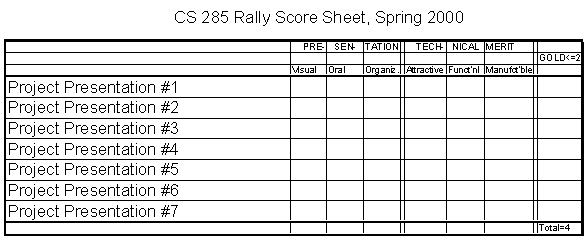Project Proposal Presentations
This is an important part of your projects,
and I want to make sure that everybody understands
what they have to do and then can give it their best shot.
{Numerically, your written project proposal and this formal presentation
account for about 15% of your course grade.}
Everybody will make a formal presentation
of their proposed course projects in front of the class.
This is an exercise that should teach you how to "sell" your ideas
to somebody "important", i.e. your boss, a venture capitalist,
or a NSF site review panel ...
The key constraint is that the attention span of "big-shots"
is very limited, and your presentation time also has a hard limit.
Formal Presentation
This is a formal presentation; with foils, and possible props, and all.
The form as well as the content of your presentation will be judged (see below).
There is a hard time limit of between 5 to 7 minutes
on your un-interrupted, formal presentation time.
Rehearse your talk to make sure it fits within these time limit.
Everybody in class will be given a work-sheet / rating-form.

On it there are columns that suggest what you should judge:
- The Presentation in terms of:
- -- visual quality,
- -- oral quality,
- -- organization;
and
- The Technical Merit in terms of:
- -- the neatness of the general idea,
- -- the usefulness of the final product,
- -- the credibility of the proposed plan of attack.
You can use your on rating system in these columns, but what counts is the last column,
where you decide how you would want do distribute "four bags of gold"
among the presenting teams.
I will collect the rating sheets after the rally,
and reveal the results in the following lecture.
Hints for a Good Proposal Presentation
- Make sure you capture and keep the attention of the audience.
- -- Be enthusiastic about your proposal !
- -- Use graphics -- use color !
- -- Keep foils simple -- one thought per slide.
- -- Stay within alloted time -- rehearse your talk.
- Make sure audience understands what you propose to do.
- -- State the problem or "void" that your work is going to fix / fill.
- -- Describe clearly what you plan to deliver.
- -- Provide good feel (visuals / mock-up) how your deliverables can be used.
- Make sure audience believes that your plan is real
and that you can do it.
- -- Show a convincing plan of attack; perhaps a preliminary partial solution.
- -- Show analogies with similar work successfully done before.
- -- Show possible extensions, and alternative fall-back solutions.
- - > CS 285 HOME < - -
- - > CURRENT < - -
Page Editor:
Carlo H. Séquin

